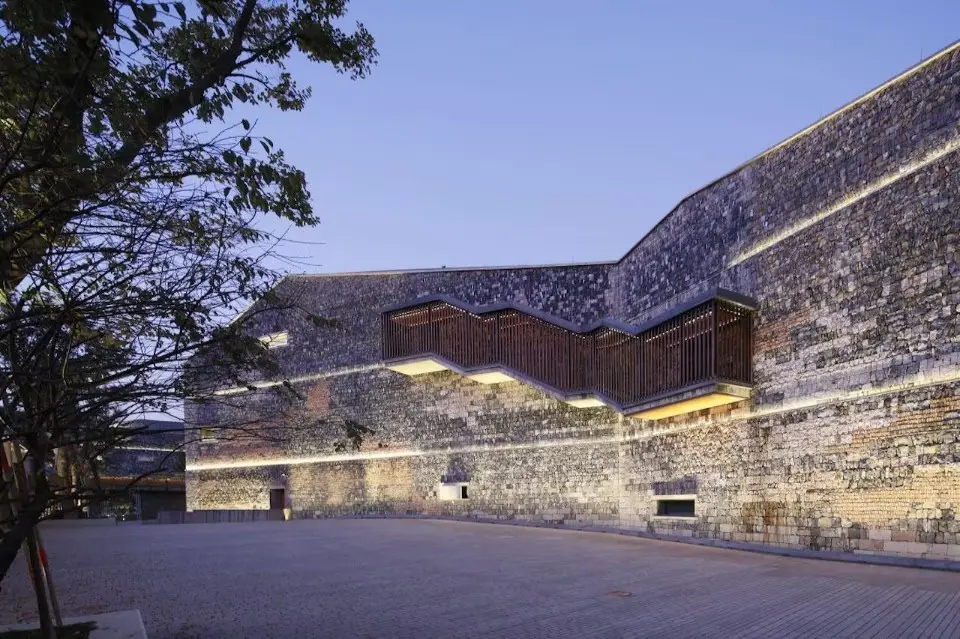Nestled in the serene town of Lin’an, just 60 kilometers west of Hangzhou, China, the Lin'an Museum stands as a testament to architectural brilliance. Designed by Amateur Architecture Studio, founded by the renowned Pritzker Prize-winning architect Wang Shu and his talented wife Lu Wenyu, this museum is a harmonious blend of tradition and modernity. In this article, we delve into the captivating story of Lin'an Museum and its architectural marvels.
A Glimpse into Lin'an Museum
The Lin'an Museum project was commissioned by the town of Lin’an to house its remarkable collection of ancient artifacts belonging to the esteemed Qian family. However, this museum is not just a repository of history; it is a work of art in itself.
The complex comprises two main sections: a commercial block to the north, which features shops selling local crafts, and the museum complex to the south. These wings not only offer protection from the hustle and bustle of the main road but also create a tranquil garden, lush parkland, and a picturesque lake that are open to the public.
Wang Shu's Artistic Vision
Wang Shu, also known as the dean of architecture at the nearby China Academy of Art in Hangzhou, is the creative genius behind Lin'an Museum. His vision for this architectural masterpiece was deeply rooted in local craftsmanship and urban memory. The result is a stunning kaleidoscope of materials, ranging from traditional elements like brick, stone, rubble, gravel, mud, wood, and reclaimed tiles to more contemporary materials such as steel, concrete, and plaster.
To pay homage to the site's original farming purpose, Wang Shu drew inspiration from the forms of 'villages, farmlands, and modest dwellings.' The museum's design reflects the concept of 'architecture as a mountain,' contrasting with the breathtaking Gongchen Mountains to the east and the serene lake to the south. This architectural approach mirrors the essence of traditional Chinese landscape paintings.
A Journey Through History
Upon entering the museum from the south through the main plaza, visitors embark on a journey through a series of individual museum halls. These halls boast curved pitch roofs and dramatic eaves structures that echo a simple residential architectural style. Each hall narrates different aspects of the Qian family history, and the path zigzags gracefully up the gently sloping site. Occasionally, visitors find themselves on external bridges and walkways, reminiscent of those in Xiangshan Campus in Hangzhou, a building that initially brought Wang Shu to international acclaim.
Integration with Nature
The Lin'an Museum seamlessly envelops the site, creating a protected space within. Throughout the grounds, there are several cleverly integrated ancillary structures, including teahouses, service centers, and toilet blocks, all of which blend harmoniously with the landscape, never distracting from its natural beauty. This careful integration with the surroundings is a testament to Wang Shu's mastery in designing structures that respect their environment.
A Must-Visit for Architecture Enthusiasts
Lin'an Museum is not just a repository of historical artifacts; it's a living testament to the fusion of tradition and modernity. For anyone embarking on a Wang Shu pilgrimage, this remarkable architectural wonder should undoubtedly be on the list. It's a place where history, art, and nature coexist in perfect harmony, leaving visitors in awe of the timeless beauty of Lin'an Museum.
In conclusion, the Lin'an Museum is a true architectural gem, where the past meets the present in a symphony of design and natural beauty. It stands as a testament to Wang Shu's vision and the ability of architecture to weave history and innovation into a single, breathtaking experience. If you find yourself in Lin’an, make sure to add this museum to your must-visit list for a journey through time and artistry.
